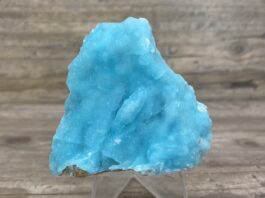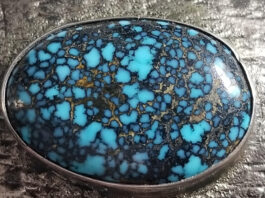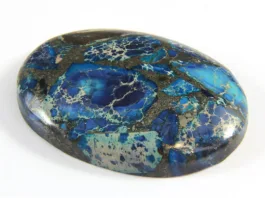Blue Goldstone is a type of synthetic glass that is often mistaken for a natural gemstone due to its glittering appearance. It is also known as “Blue Sandstone” or “Stellaria.” The name “Blue Goldstone” is derived from the sparkling metallic copper flecks suspended within the deep blue or purplish glass, giving it a resemblance to a starry night sky.

Blue Goldstone is a man-made glass that incorporates tiny copper crystals, which provide its distinctive shimmering effect. The glass is typically colored blue or purplish, and the metallic inclusions give it a striking resemblance to natural aventurine quartz or certain types of minerals. The creation of Blue Goldstone involves melting quartz sand, copper oxide, and other metal oxides at high temperatures.
Brief History and Origin: It has a relatively short history compared to many other gemstones, as it was first produced in the 17th century by Italian glassmakers. According to legend, Blue Goldstone’s origin is tied to a serendipitous accident in which a group of alchemists in Venice accidentally spilled copper shavings into a pot of molten glass, creating the characteristic sparkly appearance.
While the creation of that is a deliberate process today, the original story adds a touch of mystique to its history. It quickly gained popularity as a decorative material, and its use expanded to jewelry and other ornamental items.
It’s important to note that is not a naturally occurring mineral but rather a synthetic material crafted through human ingenuity. Despite its artificial origins, it has found a place in the world of jewelry and decorative arts due to its captivating appearance and affordability compared to some natural gemstones with similar visual characteristics.
Contents
Composition and Formation

Composition of Blue Goldstone: The basic composition of it involves a mix of quartz sand, copper oxide, and other metal oxides. The primary component, quartz sand, provides the glassy matrix, while the copper oxide is responsible for the distinctive glittering copper crystals within the glass. The other metal oxides used can contribute to the coloration and other visual effects.
Here’s a breakdown of the main components:
- Quartz Sand: The main component, providing the glassy structure.
- Copper Oxide: Creates the sparkling copper crystals within the glass.
- Other Metal Oxides: Additional metal oxides may be added to achieve specific colors or visual effects.
Manufacturing Process:
The manufacturing process of Blue Goldstone involves carefully controlled conditions to produce the desired appearance. Here is a simplified overview of the process:
- Melting Raw Materials:
- Quartz sand and other raw materials, including copper oxide and other metal oxides, are mixed in precise proportions.
- The mixture is then heated to high temperatures in a furnace, melting the ingredients into a molten glass.
- Formation of Copper Crystals:
- Copper crystals are formed within the molten glass by introducing copper oxide into the mix. The copper oxide decomposes during the melting process, releasing copper ions.
- As the molten glass cools, the copper ions precipitate into small crystals, creating the characteristic glittering effect.
- Shaping and Cutting:
- Once the Blue Goldstone has solidified, it can be shaped and cut into various forms. This includes cabochons, beads, and other jewelry components.
- Polishing:
- The shaped Blue Goldstone is then polished to enhance its luster and bring out the glittering effect.
- Final Inspection:
- The finished Blue Goldstone products undergo a final inspection to ensure quality and to verify that they meet the desired visual standards.
It’s important to emphasize that Blue Goldstone is a synthetic material, and its manufacturing process is intentionally designed to mimic the appearance of natural gemstones like aventurine quartz. The process allows for creative control over the color, size, and density of the copper crystals, resulting in the distinctive and attractive appearance for which Blue Goldstone is known.
Physical Characteristics of Blue Goldstone

- Color:
- The base color of Blue Goldstone is typically deep blue or purplish, resembling the night sky.
- The color is enhanced by the presence of glittering metallic copper crystals.
- Sparkling Effect:
- The most distinctive feature of Blue Goldstone is its sparkling appearance, created by the presence of numerous tiny copper crystals within the glass.
- The glittering effect is often described as resembling stars in the night sky.
- Transparency:
- Blue Goldstone is generally opaque, meaning it does not allow light to pass through.
- Luster:
- Blue Goldstone exhibits a glassy or vitreous luster when polished.
- Hardness:
- The hardness of Blue Goldstone is relatively low compared to natural gemstones. It typically falls in the range of 5.5 to 6.5 on the Mohs scale.
- Density:
- Blue Goldstone has a density that is characteristic of glass, making it lighter than many natural gemstones.
- Cut and Shape:
- Blue Goldstone is often cut into cabochons for use in jewelry.
- Cabochons are polished, rounded, and convex gems with no facets, showcasing the glittering internal structure.
- Size of Copper Crystals:
- The size and density of the copper crystals within Blue Goldstone can vary. Finer particles may create a more even, shimmering effect, while larger crystals may be more noticeable.
- Temperature Resistance:
- Blue Goldstone, being a type of glass, can withstand moderate temperatures. However, it is not as heat-resistant as some natural gemstones.
- Fracture and Cleavage:
- Blue Goldstone may exhibit conchoidal fractures, similar to glass. It does not have significant cleavage.
- Refractive Index:
- The refractive index of Blue Goldstone is relatively low, contributing to its glassy appearance.
Understanding these physical characteristics is important for both appreciating the unique qualities of Blue Goldstone and properly caring for items made from this material, such as jewelry.
Uses of Blue Goldstone

Blue Goldstone, with its distinctive appearance and sparkling effect, is used in various applications, primarily in the realm of jewelry and decorative arts. Here are some common uses:
- Jewelry:
- Beads and Bracelets: Blue Goldstone beads are popular in jewelry making, and they are often used in bracelets and necklaces.
- Cabochons: Shaped and polished Blue Goldstone cabochons are used in rings, earrings, pendants, and other jewelry items.
- Ornamental Items:
- Carvings and Figurines: Blue Goldstone is sometimes carved into decorative figurines, beads, or other ornamental items.
- Sculptures: Artists may use Blue Goldstone as a medium for creating sculptures and other art pieces.
- Home Décor:
- Vases and Bowls: Blue Goldstone may be incorporated into decorative vases, bowls, or other home décor items.
- Inlays: The material is used for inlay work in furniture or other decorative pieces.
- Accessories:
- Keychains and Accessories: Small Blue Goldstone pieces are sometimes used in accessories such as keychains and other decorative items.
- Gift Items:
- Gift Sets: Blue Goldstone jewelry sets, such as earrings and pendants, are often packaged as attractive gift items.
- Spiritual and Metaphysical Uses:
- Healing and Meditation: Some individuals believe in the metaphysical properties of Blue Goldstone, associating it with properties like courage and positive energy. It may be used in meditation or as a healing stone.
- Crafts and DIY Projects:
- Craft Projects: Blue Goldstone beads and cabochons are popular choices for craft projects, allowing individuals to incorporate the unique glittering effect into various creations.
- Costume Jewelry:
- Costume Accessories: Blue Goldstone is sometimes used in costume jewelry due to its attractive appearance and affordability compared to certain natural gemstones.
- Gifting:
- Birthdays and Special Occasions: Blue Goldstone jewelry or decorative items are often chosen as gifts for birthdays, anniversaries, and other special occasions.
It’s important to note that while is valued for its visual appeal, it is a synthetic material. Therefore, it is typically more affordable than many natural gemstones, making it an accessible option for a wide range of applications and personal preferences.
Comparisons with Natural Gemstones

Blue Goldstone, being a synthetic material, exhibits characteristics that distinguish it from natural gemstones. Here are some key comparisons with natural gemstones:
- Origin:
- Blue Goldstone: Man-made glass with copper inclusions, created through a controlled manufacturing process.
- Natural Gemstones: Formed through natural geological processes over time, often involving minerals and crystalline structures.
- Composition:
- Blue Goldstone: Composed of quartz sand, copper oxide, and other metal oxides.
- Natural Gemstones: Have diverse compositions depending on the type of gemstone (e.g., diamonds, rubies, sapphires, emeralds).
- Hardness:
- Blue Goldstone: Has a hardness ranging from 5.5 to 6.5 on the Mohs scale.
- Natural Gemstones: Varies widely; some gemstones, like diamonds, are much harder (10 on the Mohs scale), while others may be softer.
- Luster:
- Blue Goldstone: Exhibits a glassy or vitreous luster.
- Natural Gemstones: Luster varies among different gemstones; for example, diamonds have a brilliant adamantine luster.
- Transparency:
- Blue Goldstone: Typically opaque.
- Natural Gemstones: Can be transparent, translucent, or opaque, depending on the type of gemstone.
- Color:
- Blue Goldstone: Comes in deep blue or purplish colors with a characteristic glittering effect from copper crystals.
- Natural Gemstones: Display a wide range of colors, with some gemstones having color variations due to impurities.
- Inclusions:
- Blue Goldstone: Contains intentional inclusions in the form of copper crystals for the sparkling effect.
- Natural Gemstones: May have inclusions formed during their natural growth, affecting their clarity and value.
- Formation Time:
- Blue Goldstone: Created relatively quickly through a controlled manufacturing process.
- Natural Gemstones: Formed over geological time, often taking thousands to millions of years.
- Cost:
- Blue Goldstone: Generally more affordable compared to many natural gemstones due to its synthetic nature.
- Natural Gemstones: Prices can vary widely based on rarity, quality, and demand.
- Use in Jewelry:
- Blue Goldstone: Popular for costume jewelry, beads, and cabochons.
- Natural Gemstones: Used extensively in fine jewelry, with some gems highly valued for their rarity and beauty.
While Blue Goldstone may not have the geological and mineralogical significance of natural gemstones, its unique appearance and affordability make it a popular choice for various decorative and jewelry applications. Natural gemstones, on the other hand, are valued for their rarity, durability, and diverse physical properties shaped by nature.






